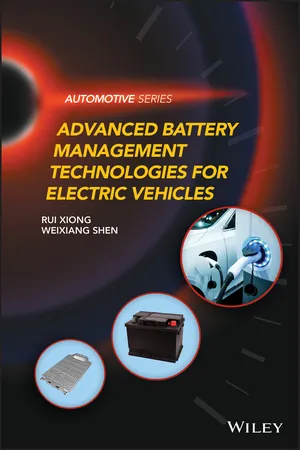
Advanced Battery Management Technologies for Electric Vehicles
Rui Xiong, Weixiang Shen
- English
- ePUB (apto para móviles)
- Disponible en iOS y Android
Advanced Battery Management Technologies for Electric Vehicles
Rui Xiong, Weixiang Shen
Información del libro
A comprehensive examination of advanced battery management technologies and practices in modern electric vehicles
Policies surrounding energy sustainability and environmental impact have become of increasing interest to governments, industries, and the general public worldwide. Policies embracing strategies that reduce fossil fuel dependency and greenhouse gas emissions have driven the widespread adoption of electric vehicles (EVs), including hybrid electric vehicles (HEVs), pure electric vehicles (PEVs) and plug-in electric vehicles (PHEVs). Battery management systems (BMSs) are crucial components of such vehicles, protecting a battery system from operating outside its Safe Operating Area (SOA), monitoring its working conditions, calculating and reporting its states, and charging and balancing the battery system. Advanced Battery Management Technologies for Electric Vehicles is a compilation of contemporary model-based state estimation methods and battery charging and balancing techniques, providing readers with practical knowledge of both fundamental concepts and practical applications.
This timely and highly-relevant text covers essential areas such as battery modeling and battery state of charge, energy, health and power estimation methods. Clear and accurate background information, relevant case studies, chapter summaries, and reference citations help readers to fully comprehend each topic in a practical context.
- Offers up-to-date coverage of modern battery management technology and practice
- Provides case studies of real-world engineering applications
- Guides readers from electric vehicle fundamentals to advanced battery management topics
- Includes chapter introductions and summaries, case studies, and color charts, graphs, and illustrations
Suitable for advanced undergraduate and graduate coursework, Advanced Battery Management Technologies for Electric Vehicles is equally valuable as a reference for professional researchers and engineers.